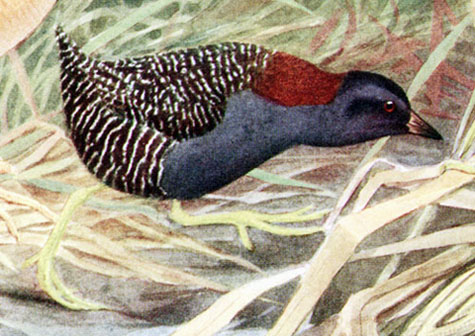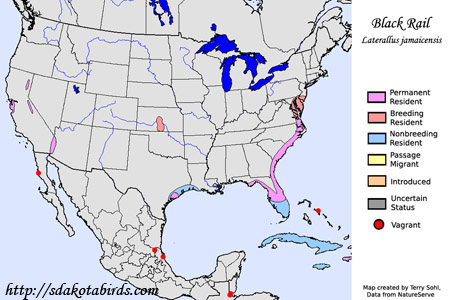Black Rail
Laterallus jamaicensis
| Length: 6 inches | Wingspan: 9 inches | Seasonality: Rare visitor |
| ID Keys: Tiny (sparrow) size, dark with speckled white on back, rusty-colored nape | ||
 Like
the Yellow Rail, Black Rails are
extremely secretive birds, and are rarely seen by humans. They are the
smallest of the rails found in the United States, just sparrow sized.
In their marsh habitat, they rarely fly, instead prefering to move through
marsh vegetation on foot, often using the pathways and openings created by
small rodents. Given their behavior, their status inland in most of
the U.S. is something of a mystery. Indeed, Black Rails had never been
confirmed in South Dakota until 2010, when breeding was confirmed in the
northeast part of the state. The best chance for a birder to come
across a Black Rail is by hearing the male's territorial calls late at
night. Mimicking the bird's calls can even sometimes lure the birds
into visual range of a flashlight.
Like
the Yellow Rail, Black Rails are
extremely secretive birds, and are rarely seen by humans. They are the
smallest of the rails found in the United States, just sparrow sized.
In their marsh habitat, they rarely fly, instead prefering to move through
marsh vegetation on foot, often using the pathways and openings created by
small rodents. Given their behavior, their status inland in most of
the U.S. is something of a mystery. Indeed, Black Rails had never been
confirmed in South Dakota until 2010, when breeding was confirmed in the
northeast part of the state. The best chance for a birder to come
across a Black Rail is by hearing the male's territorial calls late at
night. Mimicking the bird's calls can even sometimes lure the birds
into visual range of a flashlight.
Habitat: Black Rails are found near the highest tide line in coastal marshes. Inland, they tend to be found in areas with very shallow water, or even just moist soil, with signfiicant marsh vegetation.
Diet: Diet isn't well known, they probably feed on a variety of food items, including both vegetation (primarily seeds of marsh plants) and insects and small invertebrates.
Behavior: Black Rails are rarely ever seen in flight, as they prefer to scamper away on foot through their marshy habitat if they are disturbed. They do appear to feed during both day and night.
Breeding: There is insufficient data on breeding status within South Dakota, although breeding was confirmed in the northeastern part of the state in 2010.
Interactive eBird Map: Click to access an interactive eBird map of Black Rail sightings
Song: Male Black Rails sing a short territorial call, primarily late at night. The call is typically comprised of a pair of higher notes followed by a lower note, but the number of notes is variable.
Migration: Birds in California and elsehwere in the West appear to be permanent residents. Black Rails do appear to withdraw from northern areas in the winter, however. Inland birds, particularly those in the north, are likely strongly migratory, while those along the East Coast may only be short-distance migrants.
Similar Species: Generally distinctive in appearance
Conservation Status: Black Rails undoubtedly are present in smaller numbers and over a more restricted range than prior to European settlement. In areas where inland freshwater wetlands have been drained or otherwise converted to other land uses, numbers have probably suffered the most. Coastal populations may be stable in areas with little disturbance of tidal marshes.
Further Information: 1) Audubon Guide - Black Rail
2) Cornell Lab of Ornithology - Black Rail
Photo Information: Public domain image. If you happen to have a photo to share on this site, let me know!!
| Click on the map below for a higher-resolution view |
 |
| South Dakota Status: Black Rails were unknown in the state until 2010, when a confirmed sighting, as well as confirmed breeding, was obtained in the northeast part of the state. Given the extremely secretive nature of the species, however, it may be possible the bird is present in the state to a wider degree than sightings suggest. |
Additional Black Rail Photos (Coming soon!! If by miracle I see one!!!)
